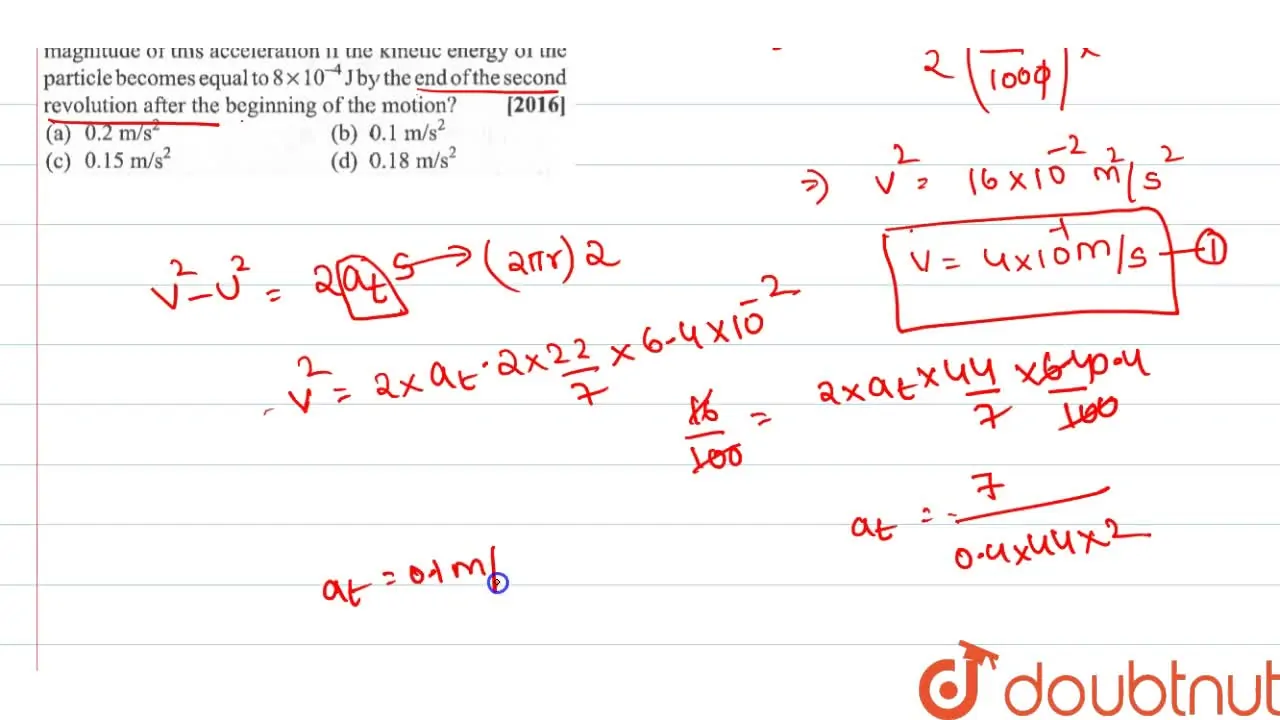A paritcal of mass 10g moves along a circle of radius 6.4cm with a constant tangennitial acceleration. What is the magnitude of this acceleration . What is the magnitude of this acceleration if the kinetic energy of the partical becomes equal to 8×10−4J by the end of the second revolution after the beginning of the motion?
0.15m/s2
0.18m/s2
0.2m/s2
0.1m/s2
The correct Answer is:d
(d) Given, mass of particle m=0.01kg
Radius of circle along which particle is moving, r=6.4cm.
∴ Kinetic energy of particle, KE=8×10−4J
⇒12mv2=8×10−4J
⇒v2=16×10−40.01=16×10−2 .....(i)
As it is given that KE of particle is equal to 8×10−4J by the end of second revolution after the beginning of motion of particle. It means, its intial velocity (u) is 0m/s at this moment.
∴ By Newton's 3rd equation of motion,
v2=u2+2ats
⇒v2=2atsor v2=2at(4πr)
(∴ particle covers 2 revolutions)n
at=v28πr=16×108×3.14×6.4×10−4
(∴ from eq. (i), V2=16×10−2)
∴at=0.1m/s2
Related Playlists
Similar Questions
A particle of mass 10 g moves along a circle of radius 6.4 cm with a constant tangential acceleration. What is the magnitude of this acceleration. What is the magnitude of this acceleration, if the kinetic energy of the particle becomes equal to 8×10−4J by the end of the second revolution after the beginning of the motion?
View SolutionA particle of mass 10 g moves along a circle of the radius 1π cm with a constant tangential acceleration. What is the magnitude of this acceleration (in ms−1) if the kinetic nergy of the particle becomes equal to 8×10−4J by the end of the second revolution after the beginning of the motion? (Particle starts from rest)
View SolutionA particle of mass 10 g moves along a circle of radius 6.4 cm with a constant tangential acceleration. What is the magnitude of this acceleration if the kinetic energy of the particle becomes equal to 8×10−4J by the end of the second revolution after the beginning of the motion?
View SolutionA particle of mass 10 g moves along a circle of radius 64 cm with a constant tangential acceleration. What is the magnitude of this acceleration if the kinetic energy of the particle becomes equal to 8×10−4J by the end of the second revolution after the beginning of the motion ?
View SolutionA particle of mass 10 g moves along a circle of radius 64 cm with a constant tangential acceleration. What is the magnitude of this acceleration if the kinetic energy of the particle becomes equal to 8×10−4J by the end of the second revolution after the beginning of the motion ?
View SolutionA particle moves along a circle of radius 40π m with constant tangental acceleration. If the velocity of the particle is 100 m/s at the end of the 4th revolution after motion has begin, the tangential acceleration is
View SolutionA particle moves along a circle of radius r with constant tangential acceleration. If the velocity of the particle is v at the end of second revolution, after the revolution has started, then the tangential acceleration is
View SolutionA particle moves along a circle of radius r with constant tangential acceleration. If the velocity of the particle is v at the end of second revolution, after the revolution has started, then the tangential acceleration is
View SolutionA particle moves in a circle of radius 2 m at a second
what is its resultant (total ) acceleration at time t=1 s ?View SolutionA point moves along a circle having a radius 20cm with a constant tangential acceleration 5cm/s2. How much time (in sec) is needed after motion begins for the normal acceleration of the point to be equal to tangential acceleration?
View Solution


